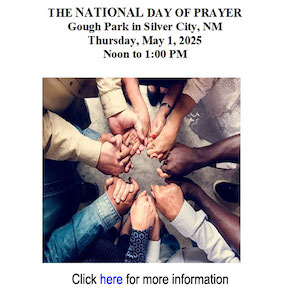The Chronicles Of Grant County
Tax Day
April 15, 2025
See the PDF below in the text to see what page one of the first Form 1040 looked like in 1913.
(The image was provided courtesy of the National Archives.)
Today is Tax Day for most Americans.
While some farmers, ranchers, and other business people do have other due dates, for many, today is the day they have to pay any income taxes that remain due for Year 2024. This includes many Americans who have filed extensions with the Internal Revenue Service.
In addition, today is the date when a number of people have to pay estimated income taxes for the first quarter of Year 2025.
Residents of Southwest New Mexico have state officials in Santa Fe (as well as Dover and Cheyenne) to thank for having to pay the Federal Income Tax.
On February 3, 1913, state legislators in Delaware, New Mexico, and Wyoming approved the 16th Amendment to the United States Constitution. These states were the 36th, 37th, and 38th states to ratify this amendment. Approval of 36 of the then 48 states was necessary for the amendment to be added to the U S Constitution.
The text for this amendment is as follows:
"The Congress shall have the power to lay and collect taxes on incomes, from whatever source derived, without apportionment among the several States, and without regard to any census or enumeration."
According to the National Archives, "…on February 25, 1913, with the certification by [United States] Secretary of State Philander Knox, the 16th Amendment took effect."
Thus, the modern Federal income tax was born.
The first Form 1040 (yes, they called it a "1040" even in 1913) noted that the "normal tax [rate] of 1%" was to be paid on taxable income by March 1st of the following year.
The 1% tax rate was assessed on taxable income (gross income minus certain deductions and exemptions) up to $20,000.00. According to the United States Bureau of Labor Statistics (U S BLS), that amount in March of 1913 would have equated to $651,187.76 in February of 2025.
While few deductions and exemptions were allowed in 1913, the ones that were provided removed most Americans from having to pay any Federal income tax.
If you were single and had income less than $3,000.00, you did not pay any Federal income taxes. According to the U S BLS, that amount in March of 1913 would have equated to $97,678.16 in February of 2025.
If you were married and had income less than $4,000.00, you also did not pay any Federal income taxes. The U S BLS indicated that amount in March of 1913 would have equated to $130,237.55 in February of 2025.
"…In 1913, due to generous exemptions and deductions, less than 1 percent of the population paid income taxes at the rate of only 1 percent of net income," according to the National Archives.
In addition to the "normal tax," there was an "additional or super tax" on taxable incomes of more than $20,000.00 in 2013.
During that year, there was a 1% additional tax on the taxable income over $20,000.00 and not exceeding $50,000.00; 2% additional tax on the taxable income over $50,000.00 and not exceeding $75,000.00; 3% additional tax on the taxable income over $75,000.00 and not exceeding $100,000.00; 4% additional tax on the taxable income over $100,000.00 and not exceeding $250,000.00; 5% additional tax on the taxable income over $250,000.00 and not exceeding $500,000.00; and 6% additional tax on the taxable income over $500,000.00.
To put these numbers into perspective, the U S BLS indicated that $50,000.00 in March of 1913 would equate to $1,627,969.39 in February of 2025; $500,000.00 in March of 1913 would equate to $16,279,693.88 in February of 2025.
The highest Federal income tax rate was 7% in 1913.
Be glad it's not 1944 or 1945.
In those years, the highest marginal tax rate for Federal income taxes was 94%.
Yes, 94%.
The Federal income tax has come a long way from the time when less than 1% of Americans paid a "normal tax" of 1% and a small number of Americans paid an "additional or super tax" of up to 6% extra on net income in 1913.
Do you have questions about communities in Grant County and Southwest New Mexico?
A street name? A building?
Your questions may be used in a future news column.
Contact Richard McDonough at
If your email does not go through, please contact
© 2025 Richard McDonough











